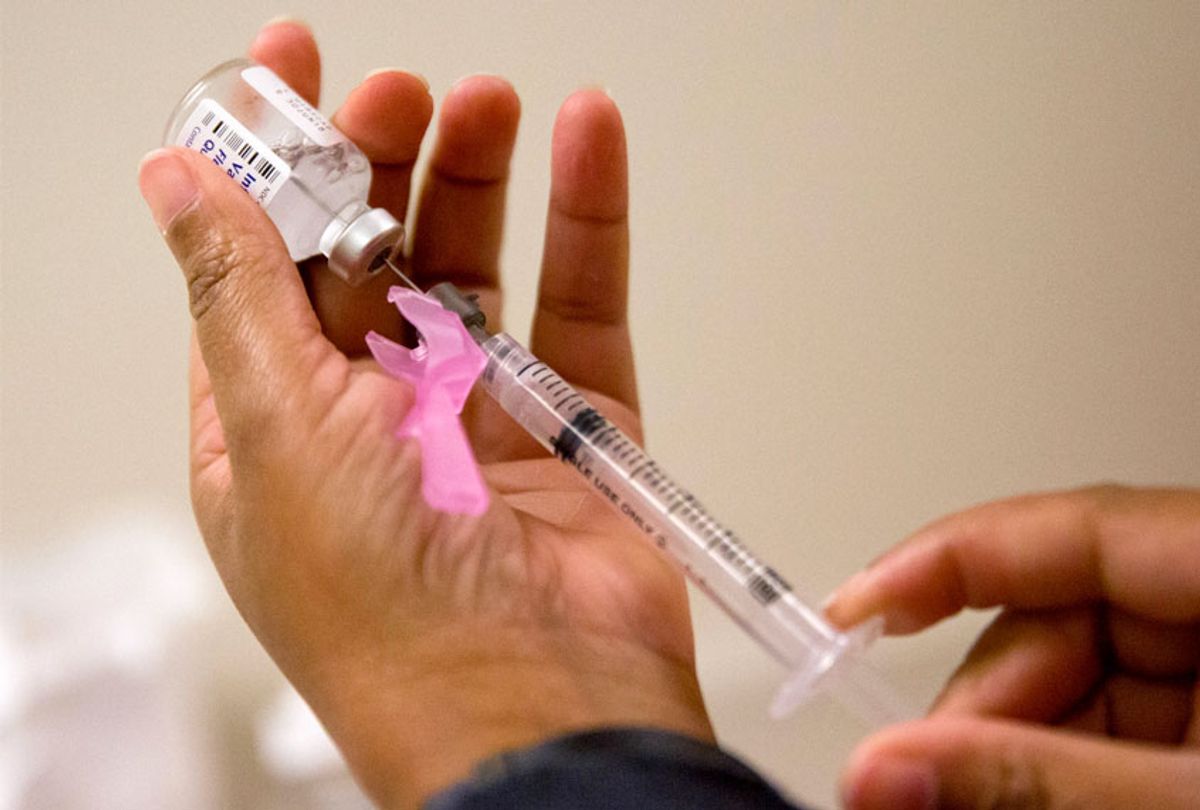Holiday parties make for interesting small talk, and sometimes that means answering one big health question: “Did you get a flu shot?” According to a recent survey by NORC, a research organization at the University of Chicago, nearly half of Americans will reply “no” this year.
NORC, who conducts the National Immunization Survey for the U.S Centers for Disease Control and Prevention, found that as of mid-November only 43 percent of people over the age of 18 said they had been vaccinated against the flu. The CDC recommended everyone over six months old to get a flu shot by the end of October. Fourteen percent of those unvaccinated said they still intend to get the shot. If they all do, that will leave an estimated 41 without the vaccination this season.
Those numbers are up slightly from last year's estimate of 37 percent for the 2017-18 flu season, while the year before 43 percent of American adults were estimated to have been vaccinated for the flu.
“Flu vaccination helps prevent people from getting sick with the flu and reduces the severity of illness for those who do get sick. Widespread vaccination also helps create ‘herd immunity’ that protects vulnerable groups who are prevented from getting vaccinated,” Caroline Pearson, senior fellow at NORC at the University of Chicago said in a statement. “Unfortunately, over half of all adults are currently unvaccinated, with 4 in 10 not intending to get vaccinated, placing themselves and those around them at risk.”
Vaccinations can help protect more vulnerable populations such as children and older adults, especially if we see another severe outbreak like last year's. According to the survey, adults over age 60 — who are at higher risk for complications from the flu — do have the highest vaccination rate this season.
While getting the flu shot is an individual choice, it can impact public health trends. This is why the flu shot is seen as a “social responsibility” by many public health professionals.
“Getting the flu shot isn't just about keeping you safe and healthy. Getting the flu shot is about community; it's about everyone else around you. Those 80,000 people who died last year from the flu, guess what? They got the flu from someone,” U.S. Surgeon General Jerome Adams, M.D., MPH, said at a National Foundation for Infectious Diseases news conference in September. “Someone passed it along to them. So it's critically important that we impress upon folks that it is not just for them; it's their social responsibility to get vaccinated."
NORC found that many people aren’t receiving flu shots because of “misconceptions” about whether the vaccination is worth getting.
“Strategies like school and workplace flu clinics have helped make vaccines more affordable and easy to access,” said Caitlin Oppenheimer, senior vice president of Public Health Research at NORC at the University of Chicago. “Unfortunately, many people are still not getting flu shots due to broader misconceptions about the value of receiving a flu shot and concerns about the safety and efficacy of the vaccines.”
Only six percent of adults over 18 who said they do not intend to get a flu shot cited barriers to access as a reason. Thirty-six percent expressed concerns about the side effects. Thirty-one percent said they were afraid of getting sick from the flu shot. Thirty-one percent also said they don’t get vaccinated because they don’t think it works — or they have never had the flu.
“The survey seems to highlight the most common reasons people do not get the flu shot, most based on misperceptions,” Mark Smolinski, MD, MPH, and President of Ending Pandemics, told Salon in a statement. “Even if an average healthy adult person does not see themselves at risk, they can be passing the flu on to infants and/or the elderly who are at increased risk. The public health consequences of low vaccination rates in the community can lead to excess illness and death, especially during ‘bad’ flu seasons like we had last year.”
Last year’s flu season was “a high severity season,” according to the CDC, with 185 pediatric deaths reported. Eighty percent of those deaths occurred in children who had not received a vaccination. Flu deaths in adults are not reported like they are in children, but the CDC estimated that nearly 80,000 died in total.
This season has been relatively mild, but the CDC warned in its most recent Weekly FluView Report, “seasonal influenza activity continues to increase slowly in the United States.” The most common strain has been H1N1, which tends to have a better response to the vaccination.
"That's the strain that's a little bit better match to our vaccine," Richard Webby, a flu scientist, told CNN. "It tends not to have quite the same impact that the H3N2 season does, and that's what we had last year."
Smolinski told Salon it is not too late for people to get vaccinated for this season.
“While the flu vaccine is not 100 percent effective (very few vaccines achieve this level), it is better to get the flu vaccine than to not get it,” he said. “And it is not too late as we are still early in this flu season.”



Shares